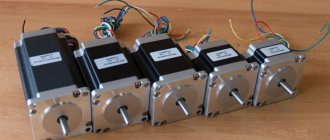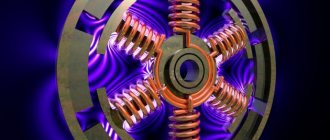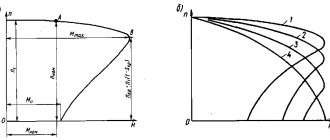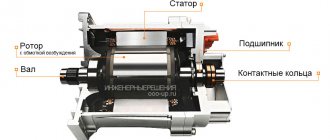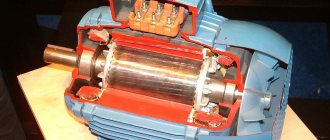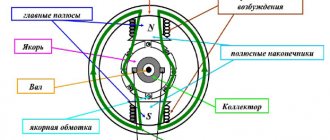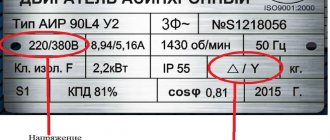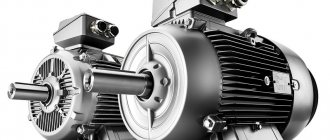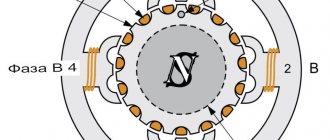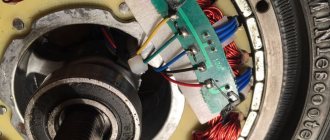March 22, 2022 kmelectric equipment and faults
Electricity today is one of the most popular sources of energy. To use it, special mechanisms are used that are capable of converting current into rotational force.
One of the most popular systems are commutator motors. They are found everywhere, as they are distinguished by their simplicity and functionality.
Single-phase and three-phase asynchronous motors
We agreed - three-phase commutator motors are difficult to obtain; the current section deals with asynchronous machines. We list the varieties:
- Three-phase asynchronous motors are equipped with a number of outputs from three to six working windings minus various fuses, internal relays, and various sensors. The stator coils inside are connected by a star, making it impossible to directly connect to a single-phase network.
- Single-phase motors equipped with a starting winding are, among other things, equipped with a pair of contacts leading to a centrifugal limit switch. The miniature device breaks the chain when the shaft is untwisted. The starting winding catalyzes the initial stage. Further action will interfere, reducing the efficiency of the engine. The design is usually called bifilar. The starting winding is wound with double wire, reducing reactance. Helps reduce the capacitance of the capacitor - critical. A striking example of single-phase asynchronous motors with a starting winding are the compressors of household refrigerators.
- The capacitor winding, different from the starting winding, operates continuously. We will find the motors inside the floor fans. The capacitor provides a phase shift of 90 degrees, allowing you to choose the direction of rotation and maintain the desired shape of the electromagnetic field inside the rotor. Typically the capacitor is mounted on the motor housing.
Three-phase asynchronous motors
- Small asynchronous motors used in hoods and fans can be started without a capacitor at all. The initial movement is formed by the flapping of the blades, or by the curvature of the rotor wiring (grooves) in the desired direction.
Let's learn how to distinguish single-phase asynchronous motors from three-phase ones. In the latter case, there are always three equal windings inside. Therefore, you can find three pairs of contacts that, when examined by a tester, give the same resistance. For example, 9 ohms. If the windings are connected by a star inside, there will be three terminals with the same resistance. Of these, any pair gives identical readings displayed on the multimeter screen. The resistance is equal to two windings each time.
Because current must flow out, sometimes a three-phase motor has a neutral terminal. The center of the star, with each of the other three wires, gives identical resistance, half that shown by the pairwise continuity. The above symptoms speak eloquently: the motor is three-phase, alien to the topic of today’s conversation.
The winding motors discussed in this section contain two. One starting or capacitor (auxiliary). There are usually three or four conclusions. If there is no capacitor decorating the case, you can try to reason, puzzled by the purpose of the contacts, as follows:
- There are four pins - you need to measure the resistance. Usually they ring in pairs. The resistance is lower - we found the main winding, connected to a 230 volt network without a capacitor. Polarity does not matter; the direction of rotation is set by the way the auxiliary winding is turned on, by switching the coils. Simply put, connect a single-phase electric motor of a characteristic type with only one main winding - in the initial period of time the shaft stands upright. Wherever you spin, there will be rotation. Beware of starting with your hand - it will break.
Asynchronous motor device
- We see three conclusions. Inside, the ends of the coils are connected to form a star. Neutral (circuit zero) is supplied. Regarding the other two terminals, the pairwise resistance will be the greatest (equal to both windings connected in series). The smallest value, as before, will be the working winding; the starting phase passes through the capacitor. Will provide a shift in the right direction. Typically, such a motor rotates unidirectionally; it is impossible to physically change the polarity of the capacitor. However, there is information (we’ll check the diagrams another time): by feeding the working coil with voltage through a capacitor, turning on the starting coil directly, we will perform a reverse. The possibility of connecting a 3-wire electric motor, implementing reverse rotation, is not mentioned in the literature.
The main problems of washing machines
If you were interested in this issue on the Internet, you probably saw similar complaints: “This is the third year of operation, and I hear a grinding noise during washing. They say that the drum bearing is acting up. Repair? It’s easier to buy a new one.”
And such reviews are not uncommon. Advertising continues to feed you promises, which is why you can inadvertently overpay for the brand, which is also unpleasant.
So, take a look at the range of washing machines and try not to be deceived by marketing tricks in the first seconds. We know companies that lure in with touch screens and futuristic forms. But your goal is to choose a durable washing machine. It's like getting married - once and for the rest of your life. Therefore, we calmly diagnose the future chosen one. What is important is the motor and only the motor - without exaggeration, the heart of the washing machine.
Assorted motors
How to make an electric motor with your own hands
Let's consider individual aspects of design. We will not promise the production of a perpetual motion machine, similar to the type of creation attributed to Tesla, but the story is expected to be interesting. We won’t bother readers with paper clips and batteries; we suggest we talk about how to adapt a ready-made motor for your own purposes. It is known that there are a lot of designs, all of them are used, but modern literature leaves the basic principles behind. The authors studied a textbook from the last century, learning how to make an electric motor with their own hands. Now we invite you to plunge into the knowledge that forms the basis of a specialist.
Definition and a little history
The author of the asynchronous motor is considered to be Mikhail Osipovich Dolivo-Dobrovolsky, who in 1889 received a patent for a motor with a “Squirrel Cage” type rotor, and in 1890 for a motor with a wound rotor, which are still used today without any special changes in design. And the first research and developments in this direction were carried out in 1888 by Galileo Ferraris and Nikola Tesla independently of each other.
The main difference between Dolivo-Dobrovolsky’s development and Tesla’s development was the use of a three-phase rather than two-phase stator design. The demonstration of the first engines took place at the International Electrotechnical Exhibition in Frankfurt am Main in September 1891. Three three-phase asynchronous electric motors were presented there, the most powerful of which was 1.5 kW. The design of these machines turned out to be so successful that it has not undergone significant changes to this day.
The definition of an asynchronous machine is as follows:
An asynchronous electric machine is an alternating current machine in which the rotor speed is not equal to the speed of the magnetic field created by the stator windings.
Design
The design of an asynchronous motor is perhaps the simplest among its analogues. It consists of a rotor and a stator. Often, a three-phase winding is located on the stator, with the exception of motors designed to operate in a single-phase network with a two-phase winding or with a working and starting winding. The stator consists of a metal body and a core with windings (actually they are called the stator winding).
Since the motor is powered by alternating current, a problem arises associated with losses due to stray currents (so-called Foucault currents), for this the stator core is made of thin plates. To prevent contact with each other, steel plates are insulated with scale and secured with varnish. The current flowing in the stator windings is called stator current.
The stator housing is closed on both sides with bearing shields; sliding or rolling bearings are respectively installed in them, depending on the power and size of the machine. The bearings are covered with caps, this is necessary for their lubrication; usually they use grease such as lithol, grease and the like.
Less commonly, large and powerful electrical machines may use journal bearings with a circulating lubrication system (liquid lubrication). An oil pump pumps oil into them; in operating mode, the rotor of such machines slides over a thin oil film, similar to what happens in liners on internal combustion engines.
Based on the design of the housing and the type of fastening, motors are distinguished between lamp-mounted or flange-mounted; they also come with a combined type of fastening - with paws and a flange.
Depending on the type of engine, the shaft can come out of it from one or both sides. An actuator is attached to it; for this purpose, the end is made of a conical or cylindrical shape or with a groove for installing a key and connecting to the actuator.
Most electric motors use forced air cooling. To do this, ribs are placed longitudinally on the housing, and a cooling fan impeller is installed at the other end of the shaft. While the engine is running, it rotates and pushes air along the ribs, taking heat from the stator.
Other comparisons
When comparing commutator and asynchronous motors of the same power, regardless of the rated frequency of the latter, different characteristics are obtained. This will be described in more detail below. The universal commutator motor implements a “soft” characteristic. In this case, the torque is directly proportional to the load on the shaft, while the speed is inversely proportional to it. The rated torque is usually 3-5 times less than the maximum. Limiting the idle speed is characterized solely by losses in the engine, and when turning on a powerful unit without load, it can be destroyed.
The characteristic of an asynchronous motor is “fan”, that is, the unit maintains a rotation speed close to the nominal one, increasing the torque as sharply as possible with a slight decrease in speed. If we are talking about a significant change in this indicator, then the engine torque not only does not increase, but also drops to zero, which leads to a complete stop. The idle speed is slightly higher than the nominal speed, but remains constant. A single-phase induction motor has an additional set of starting problems because it does not develop starting torque under normal conditions. The magnetic field of a single-phase stator, pulsating in time, breaks up into two fields with opposite phases, which makes starting impossible without all sorts of tricks:
A container that creates an artificial phase;
Active resistance forming an artificial phase.
Theoretically, a field rotating in antiphase reduces the maximum efficiency of a single-phase asynchronous unit to 50-60% due to losses in the oversaturated magnetic system and windings loaded with counter-field currents. It turns out that there are two electric machines on one shaft, one operating in motor mode, and the second in counter-switching mode. It turns out that single-phase commutator electric motors do not know competitors in the corresponding networks. This is what earned them such high popularity.
The mechanical characteristics of the electric motor provide it with a specific scope of use. Low speeds, limited by the frequency of the alternating current network, make asynchronous units of similar power larger in weight and size compared to universal collector ones. However, when a high-frequency inverter is connected to the power supply circuit, comparable dimensions and weight can be achieved. The rigidity of the mechanical characteristics of the electric motor remains, to which losses due to current conversion are added, as well as an increase in frequency, magnetic and inductive losses increase.
Determining the parameters of the old battery
The first thing you should do is find out its technical characteristics, which you will be guided by when choosing a new battery for an uninterruptible power supply. The main parameters you need to know are voltage (V) and capacity (Ah, A/h).
The voltage must exactly match the value indicated on the old battery. Typically, batteries can be 6 or 12 volts. As for the capacity, you can choose it a little larger than it was.
It also doesn’t hurt to determine the dimensions of the battery, which can help you choose the right model if you couldn’t read some of the characteristics.
By the way, all the important parameters of the battery are in the passport of the uninterruptible power supply. If you have kept the documentation, the choice will be easier.
Pages
Reverse commutator motor
When using a switch like the one in the photo
There is a more visual diagram for connecting the reverse, maybe it will help someone.
Answer
The fact is that a motor with brushes is a brushed motor, and a motor without brushes is brushless . To solve different problems, a different type of engine is suitable - in some places a brushed motor is better, and in others you can only install a brushless motor.
Brushed motor
A commutator motor, as a rule, has only two power wires, it is easy to control; it is enough to regulate the constant or alternating supply voltage and the speed will change accordingly. You can even control a commutator motor using a simple dimmer. The main advantage of a commutator engine is high speeds (tens of thousands per minute) with high torque.
The operating principle of a commutator motor is very simple. In fact, its rotor is a set of copper frames in a magnetic circuit, which are alternately switched to the power source at the commutator-brush assembly. The stator can be either made of permanent magnets or with a winding powered from the same source as the rotor, or from a separate source, and sometimes the stator and rotor are included in a single series circuit (such as the motors of automatic washing machines).
An electric current is supplied to each section of the rotor winding, through the commutator-brush assembly, in turn, as the rotor rotates. As a result, the rotor is remagnetized, acquiring clearly defined north and south magnetic poles, due to which the rotor rotates inside the stator (the rotor poles are pushed out the stator poles, then the rotor is further remagnetized and pushed out again). Since the rotor is switched to the power source by another section each time, rotation does not stop while power is supplied to the collector.
The main disadvantage of a commutator motor
The speed of the commutator motor is very convenient to regulate, but when it is high enough, the brushes make themselves felt. Since the brushes are always in close contact with the commutator, at high speeds they quickly wear out, eventually become clogged one way or another, and eventually begin to spark.
Wear of the brushes, and the commutator-brush assembly in general, leads to a decrease in the efficiency of the commutator motor. Thus, the commutator-brush assembly itself is the main disadvantage of commutator motors . Today they are trying to abandon brushed motors in favor of brushless stepper motors.
Brushless (brushless) motor
A brushless motor has no commutator or brushes. The simplest example of a brushless motor is a three-phase induction motor with a squirrel-cage rotor. Another example of a brushless motor is a more modern one - a stepper motor with a magnetic rotor . The stator windings of a brushless motor themselves are remagnetized so that the rotor turns around all the time and rotates continuously in this way.
Most often, modern brushless motors are equipped with a rotor position sensor, based on signals from which the motor speed controller operates. The signal from the rotor position sensor is transmitted to the processor more than 100 times per second, resulting in accurate rotor positioning and high torque. There are, of course, brushless motors without a rotor position sensor; a striking example is the same asynchronous three-phase motor. Motors without a position sensor are cheaper than with a sensor.
Advantages of brushless motors
Since the service life of the rotor bearings is extremely long, we can say that the brushless motor has virtually no parts that wear out over time, and it does not require any maintenance during operation. Friction is minimized here, there is no problem of commutator overheating, and in general the reliability and efficiency of brushless motors are very high.
There are no sparking brushes, the rotor position sensor will help make the control precise - there are practically no disadvantages, only advantages. Is that the price of high-quality stepper motors is higher than that of brushed motors (plus a driver), but this is nothing compared to the regular replacement of springs, brushes and commutators for brushed motors
First, let's find out the type of engine. We will not always resolve the issue unambiguously. Appearance says little; the nameplate of an old engine may not correspond to the actual contents of the unit. We propose to briefly consider what asynchronous and commutator motors the industry produces. We will tell you the differences in operation, key properties, external and internal. Let's discuss connecting a single-phase motor to an AC mains.
Brushed vs asynchronous motors
The question - commutator motor or asynchronous - is resolved as a matter of priority. The process is simple. A collector is a drum divided by copper sections, approximately rectangular in shape, made of copper. Forms a current collector; in commutator motors, the rotor is always powered by electric current. Constant, variable - the field is created by the applied voltage.
Brushed motor
The commutator motor contains at least two brushes. We rarely see three-phase ones. Information about such units is described in literature from the middle of the last century. Three-phase commutator motors were used, regulating the shaft rotation speed over a wide range. The motor of this type is equipped with brushes and a copper drum divided into sections. It is difficult to miss the sign even with the naked eye. Examples of commutator motors:
- Vacuum cleaner, washing machine.
- Grinder, drill, electric hand tool.
Commutator motors are widely used, providing a relatively simple reverse, realized by changing the commutation of the windings. The speed is regulated by changing the supply voltage cutoff angle or amplitude. Common disadvantages of commutator motors include:
- Noisy. Friction by drum brushes cannot occur silently. When crossing the section, sparking occurs. The effect causes radio frequency interference, producing a host of extraneous sounds. Commutator motors are relatively noisy. Try to remember the vacuum cleaner. Is the washing machine not so loud when performing the washing cycle? Low speed brushed motors are good.
- The need for maintenance is determined by the presence of rubbing parts. The current collector is often contaminated with graphite. It is simply unacceptable; it can short-circuit adjacent sections. Dirt increases noise levels and other negative effects.
Everything is good in moderation. Brushed motors will allow you to obtain a given power (torque) at the start, after acceleration. It is relatively easy to adjust the speed. The reason for the fascination of household appliances with commutator varieties has been named; asynchronous motors are the heart of equipment that has increased requirements for sound pressure levels. Fans, hoods. Serious loads will require major design changes. Cost, size, and complexity increase, making production unprofitable.
A commutator engine is distinguished by the presence of... a commutator. Even if you cannot see it from the outside (hidden by the casing), we will notice the indispensable graphite brushes, pressed by springs. The part requires replacement over time; it will help to distinguish a commutator motor from an asynchronous one.
Asynchronous motor - what is it, how does it work and where is it used?
Today, there are many types of electric motors: brushed DC and universal motors, AC synchronous and asynchronous motors, brushless DC motors and permanent magnet synchronous motors, stepper motors and servos, etc. But the most common in production was, is and will be an asynchronous electric motor with a squirrel-cage rotor. In this article we will talk about what it is and what its features are.
What is the difference between a commutator motor and an asynchronous motor?
Electricity today is one of the most popular sources of energy. To use it, special mechanisms are used that are capable of converting current into rotational force.
One of the most popular systems are commutator motors. They are found everywhere, as they are distinguished by their simplicity and functionality.
How to choose a capacitor for starting a single-phase motor
We have already told you how to select a capacitor for starting a three-phase motor, but the method is not suitable in our case. Amateurs recommend trying to enter the so-called resonance. In this case, the consumption of a 9 kW unit will be about (!) 100 W. This does not mean that the shaft will pull the full load, but in idle mode the consumption will be minimal. How to connect an electric motor this way.
Amateurs recommend focusing on current consumption. At the optimal capacity value, the power will be minimal. You can estimate the current consumption using a Chinese multimeter. And so, the connection of a single-phase motor with a starting winding is carried out, guided by the electrical diagram indicated on the housing. For example, there is information there:
- The color of the cambric of a certain winding.
- Electrical switching diagram for an alternating current circuit.
- Nominal capacity used.
So, if you take a single-phase asynchronous motor, the connection diagram is often indicated on the housing.
Source
Disadvantages of commutator motors
By themselves, commutator motors do a good job of their job, but this is only until the moment when the need arises to get the highest possible speed from them at the output. It's all about the same brushes mentioned above. Since they are always in close contact with the collector, as a result of high speeds, friction occurs at the point of their contact, which will subsequently cause rapid wear of both and subsequently lead to a loss of effective electric power. engine. This is the most significant disadvantage of such motors, which negates all its positive qualities.
No sensor
To determine the rotor position, it is necessary to measure the voltage on the unused winding.
This method is applicable when the engine is rotating, otherwise it will not work. Sensorless travel controllers are easier to manufacture, which explains their widespread use.
The controllers have the following properties:
When connecting the controller, it is important to keep the wires as short as possible. Due to the occurrence of current surges at the start
If the wire is long, errors in determining the rotor position may occur. Therefore, controllers are sold with a 12-16 cm wire.
The controllers have many software settings:
The LB11880 controller shown in the figure contains a high-power brushless motor driver, that is, you can run the motor directly to the chip without additional drivers.

